 Research Article
Research Article
Hypoglycemic and Hypolipidemic Effects of GymnemaSylvestre in Alloxan Induced Diabetic Sprague DawleyRats
Abdullahi Mann and Shukurat Bisola Babalola*
Department of Chemistry, Federal University of Technology Minna, Nigeria
Shukurat Bisola Babalola, Department of Chemistry, FederalUniversity of Technology Minna, Nigeria.
Received Date: September 23, 2019; Published Date: October 01, 2019
Abstract
Background: Gymnema sylvestre is a medicinal plant use in traditional medicine for management of various diseases. The present studyinvestigated the phytochemical, anti-diabetic and hypoglycemic properties of the methanol leaves extract of Gymnema sylvestre in alloxan induceddiabetic rats.
>Methods: A total of twenty (20) alloxan (120 mg/kg bw) induced diabetic rats were grouped into 4 (A-D) and treated with 0, 250 and 500 mg/kg bw of methanol leave extract of Gymnema sylvestre and 2.5mg/kg bw glibenclimide respectively.
Results: Methanol leaves extract of Gymnema sylvestre contains saponin (23.85±2.35 mg/g) as the most abundant phytochemical in the extractfollowed by total phenol (19.77±0.55 mg/g), tannins (16.00±0.34 mg/g), alkaloids (13.84±0.06 mg/g) and total flavonoids (8.56±0.52 mg/g). Theextract at doses of 250 and 500 mg/kg bw exhibited 81.75% and 82.12% in vivo hypoglycemic and increase the weight gain of animals whencompared with untreated control. The extract at doses of 250 and 500 mg/kg also causes a significant (P<0.05) and dose dependent decrease inthe elevated triglycerides (147.37±5.52 and 145.42±5.10 mg/dL), total cholesterol (132.30±16.88 and 130.25±21.10 mg/dL), and increase highdensity-lipoprotein (21.12±0.66 and 44.03±4.58 mg/dL) when compared with triglyceride (259.32±68.79 mg/dL), total cholesterol (228.45±4.36mg/dL) and high density-lipoprotein (22.27±2.08mg/dL) in untreated rats.
Conclusion: Methanol leaf extract of Gymnema sylvestres contains important phytochemicals that has beneficial effect in reducing the elevatedblood glucose level and significant ameliorative effects on hyperglycemic induced dyslipidemia.
Keywords:Gymnema sylvestre; Hypoglycaemia; Hypolipidemia; Diabetes; Phytochemicals
Introduction
Diabetes mellitus (DM) is metabolic abnormalities that arisedue to insulin inadequacy and characterized primarily by highblood glucose level in addition to other secondary complicationslike hyperlipidemia, nephropathy organs failure, particularly, thekidney, heart, eyes, blood vessels and nerves [1]. Currently, over150,000000 people on global basis are diabetic and this likelytends to increase to 300, 000000 before 2025.It is estimated that,8.5% of adult’s population in 2014 are diabetes, and about 1.6million diabetes associated deaths occur in 2016 [2]. The currentavailable synthetic anti diabetic drugs have not been successfuldue to unintended hypoglycaemia and other side effects such renaland hepatic impairment, coma among many others [3]. Naturalproducts particularly, from plants and medicinal insects representrich sources of therapeutic agents against various diseases [4-6].Hence, the exploration of natural products as alternative, safer andmore effective anti-diabetics than the synthetic drug becomes thefinal hope for mankind.
Gymnema sylvestre is a woody, climbing plant commonly foundin central and southern India and in parts of Africa [7]. Gymnemasylvestre plays an important role in Ayurvedic medicine of Nupepeople in Niger State, Nigeria particularly for the management ofdiabetes mellitus and its associated conditions. The herb is alsouse in in folk medicine for the control of blood cholesterol levelsand obesity and besides regulation of sugar homeostasis. Presently,G. sylvestre has gain global acceptance has herbal preparationsin beverages, supplement, tablets, tea bags and confectioneries [7]. The plant has been reported for antimicrobial, anticancerand anti-inflammatory, properties. The plant is also use for thetreatment of arthritis, Parkinsonism, dental caries Parimala DPand Ramasubramaniaraja R [8], rheumatism, stomachache andas blood purifier [9]. Phytochemical studies on G. sylvestre haverevealed the presence of highly active saponins; gymnemic acids,gymnemasaponins (oleanane saponins) and gymnemasides(dammarane saponins) as the major contents [10-11]. This presentstudy was thus designed to investigate the anti-diabetic andhypolipidemic activities of methanol leaves extract of Gymnemmastlvester in alloxan-induced diabetic rats.
Materials and Methods
Sample preparation and extraction
The freshly harvested leaves of Gymnema sylvestre wereobtained from Minna area of Niger state Nigeria. Taxonomicauthentication of the plant was conducted at the Departmentof Biology, Federal University of Technology, Minna. The leaveswere thoroughly washed under running tap water to remove allcontaminants after which they were cut into pieces, dried for 2wk (37oC) and finally grounded using a grinder mill. A 50 g of theplant material was extracted with 200mL of methanol using soxhletapparatus and the resulting extract was concentrated using rotaryevaporator.
Experimental animal
Healthy Sprague Dawley rats of average weight (134.87±3.23)g were obtained from animal holding unit, Federal University ofTechnology, Minna, Niger State Nigeria. The rats were maintainedunder laboratory condition of temperature and humidity with12-hour light and dark sequence. They were allowed access to ratpellets and water ad-libitum. The study was carried out accordingto the Guide for the Care and the Use of Laboratory Animals ascontained in the Canadian Council on Animal Care Guidelines andProtocol Review were duly observed [12].
Phytochemical composition
The plant extract was analysed for the presence of somesecondary metabolite including terpenoids, alkaloids, phenolstannins, flavonoids, saponins, reducing sugar, steroids &phlobatannins using standard procedures [13-15]. Quantitativeanalysis was conducted for flavonoid, alkaloids, total phenol, tanninand saponins using standard procedures [13-15].
Anti-diabetic study
Twenty (20) albino rats were intra-peritoneally administered afreshly prepared solution of alloxan monohydrate (120 mg/kg) toovernight fasted rats. Diabetic state was confirmed by glucose levelabove 200 mg/kg bw [16]. The animals were divided into 4 groupsand were treated with 2 ml/kg of normal saline, 250 mg/kg, 500mg/kg bw extract and 2.5 mg/kg b.wt glibenclamide. All treatmentswere administered daily through oral route for 21 days. Five (5)rats were also set up as normal control. The blood glucose levelwas checked, and the weight taken after every three days. On thelast day, animals in all groups were euthanized and blood sampleswere collected and prepared to extract the serum according to themethod described in a previous study [17].
Analysis of lipid profile
Serum concentrations of lipid profile including total cholesterol,triglycerides and high-density lipoprotein (HDL) cholesterol wereassay by enzymatic colorimetric methods using using Randoxdiagnostic kit according to the manufacturer’s instructions [18-20].VLDL cholesterol was estimated as TG/5, and LDL cholesterol wascalculated using Friedewald formula [21]. as follows:
LDL (mg/dl) = TC − (HDL + VLDL).
Statistical analysis
Data were analyzed using Statistical analysis system (SAS) andpresented as means ± SEM. Comparisons between different groupswere carried out by one-way analysis of variance (ANOVA) followedby Duncan’s Multiple Range Test (DMRT). The level of significancewas set at P < 0.05 [22].
Results
Phytochemical composition
Methanol leaves extract of Gymnema sylvestre containsterpenoids, alkaloids, phenols tannis, flavonoids, saponins, reducingsugar but steroids & phlobatannins were absence. Quantitatively,saponin (23.85±2.35 mg/g) is the most abundant phytochemicalin the extract followed by total phenol (19.77±0.55 mg/g), tannins(16.00±0.34 mg/g) and alkaloids (13.84±0.06 mg/g) while totalflavonoids (8.56±0.52 mg/g) was the least (Table 2).
Antidiabetic study
Administration of methanol leaf extracts of Gymnema sylvestreat dose of 300 and 600 mg/kg caused significant (P<0.05) andprogressive decrease in blood glucose level of alloxan induceddiabetic rats (Figure 1). The extract caused 81.75% and 82.12%reduction in glucose level at doses of 250 and 500 mg/kg bwrespectively. However, rat treated with glibenclimide (2.5 mg/kgbw) shows 79.60% glucose reduction (Table 3). The methanol leafextracts of Gymnema sylvestre at 250 and 500 mg/kg as well as thestandard drug significantly improve the body weight of the animalswhen compare with untreated rats (Figure 2).
Hypolipidemic effect
A significant (P<0.05) increase in triglycerides (259.32±68.79mg/dL), total cholesterol (228.45±4.36 mg/dL), low densitylipoprotein (LDL- C) and reduction in high density-lipoprotein(22.27±2.08mg/dL) levels were observed in diabetic untreatedrat when compared with the normal glycemic rats and otherexperimental group. Administration of methanol leaf extractsof Gymnema sylvestre at dose of 250 and 500 mg/kg for 3 weekscauses a significant (P<0.05) and dose dependent decrease in theelevated triglycerides (147.37±5.52 and 145.42±5.10 mg/dL), totalcholesterol (132.30±16.88 and 130.25±21.10 mg/dL), low densitylipoprotein and increase high density-lipoprotein (21.12±0.66 and 44.03±4.58 mg/dL) compared to the diabetic untreated rats.However, there was no significant difference in the level of LDL- Cconcentration in rats treated with 250 mg/kg of the extract whencompared with untreated control (Figure 3) (Tables 1-3) (Figure1-3).
Table 1: Qualitative phytochemical composition of methanol leaf extractof Gymnema sylveser..
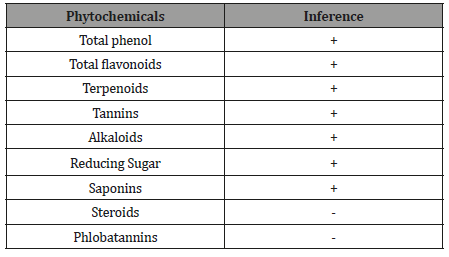
Table 2: Quantitative phytochemical compositions of methanol leafextract of Gymnema sylveser..
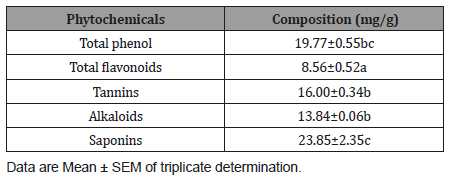
Table 3: Percentage Glucose reduction of methanol leaf extract ofGymnema sylveser in alloxan induced diabetic albino rats..

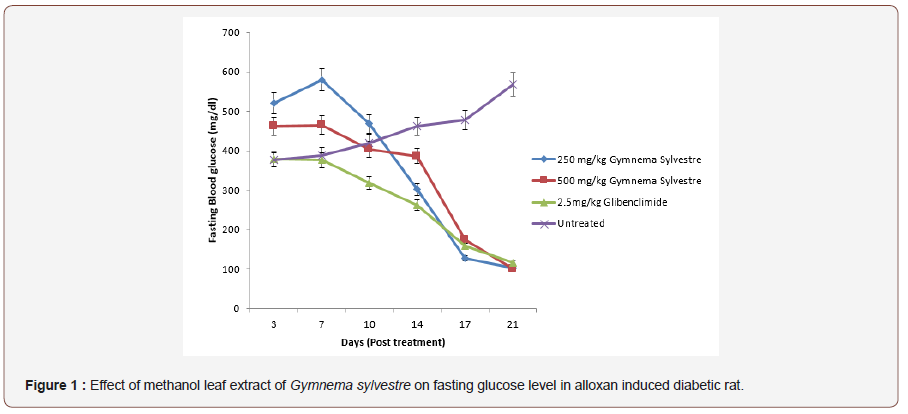
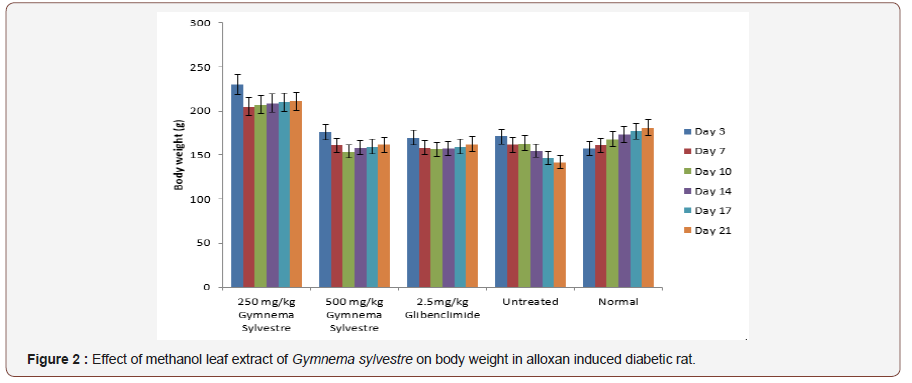
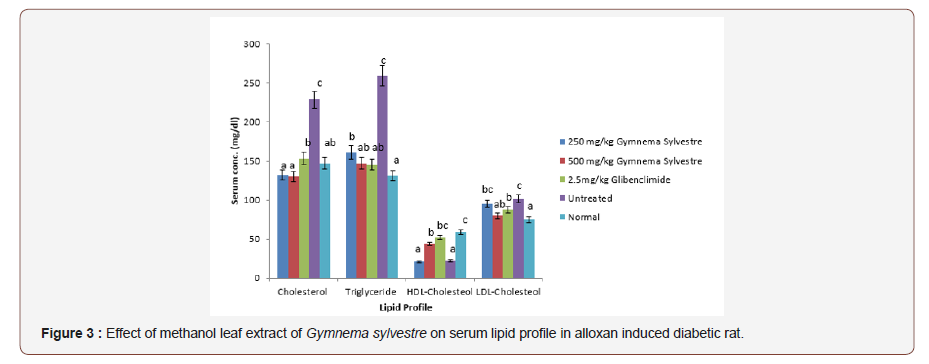
Discussion
Medicinal plants are known to contain diverse bioactivesecondary metabolites that confer pharmacological virtues to theplants. Phytochemical screening of methanol leaves extract of GGymnema sylvestre revealed the presence of appreciable amountof phytochemicals with medicinal reputations (Table 1,2). Saponinwhich was the most abundant phytochemicals (23.85±2.35 mg/g)in this plant has been previously reported for hyper-cholesterolemic[23]. Flavonoids are water soluble potent scavengers of freeradicals and super antioxidant which prevent oxidative cell damage[4]. Furthermore, flavonoids have showed a promising anti-diabeticeffect, in diabetic animal models [23]. Previous studies havedemonstrated the hypoglycemic activity of triterpenoid glycosides[24]. Therefore, the significant amounts of flavonoids (8.56±0.52mg/g) and alkaloids (13.84±0.00 mg/g) obtained in this studycould indicate strong antioxidant and antidiabetic potentials of thisplant. However, the absence of phlobatannins and steroids concordwith earlier studies which also reported that not all secondarymetabolites are present in all plants and those that present differsaccording to the solvent use in the extraction process [25].
Results from the present study revealed that administrationof alloxan results in hyperglycaemic state as evident in by markedincrease in blood glucose level. However, dose dependent reductionin blood glucose level was observed in alloxan-induced diabeticrats treated with methanol leaf extract of Gymnema sylvestres. Thesignificant hypoglycaemic effect of Gymnema sylvestres observedin this study may be linked to the presence of the phytochemicalsparticularly, flavonoids, alkaloids, sapomnins and terpenes in theextract. These compounds have been implicated in the antidiabeticactivities of many plants [26]. The progressive decrease in bodyweight observed in untreated rats could be due to the deficiencyof insulin which enhanced the breakdown of tissue proteins andsubsequently resulted into loos of body weight [27]. However, thehypoglycaemia effects demonstrated by the plant extract werecomplemented by the enhancement in the body weights of theanimals (Figure 2). A probable mechanistic approach to this findingcould be through pancreatic stimulation which enhanced secretionof insulin and the prevent glucose absorption in the gut as proposedby Tiwari et al. [7].
Abnormal lipid profile has been established to be one of themajor complications of diabetic mellitus which in turns results toatherosclerosis and cardiovascular disease. Therefore, plant withantidiabetic properties should possess favourable effect on lipidprofiles. Therefore, measurements of the level of serum lipid profilein diabetic treated rats become necessary. In the present study,administration of alloxan leads to significant increase in cholesterol,LDL and triglyceride. These high levels of triglyceride, TC andLDL are major coronary risk factors [19]. However, treatment ofmethanol, leaf extract of Gymnema sylvestres tend to restore theelevated parameters towards their normal value thereby reflectingthe hypolipidemic property of this plant.
The reductions in serum concentration of cholesterol in ratsfollowing treatment with the extract could be linked to the presenceof flavonoids, tannins and saponins that were reported to inhibithepatic synthesis of cholesterol [28]. The reduction in triglyceridecould also be attributed to the presence of alkaloids and saponins,which inhibit the absorption of dietary glucose in the GIT [29]. Theincrease in HDL concentration in serum of rats treated of methanolleaf extract of Gymnema sylvestres advocated a probable boost ofhepatic HDL-C synthesis promoted by the presence of flavonoids[23]. Hence, more cholesterol would be moved from the peripheraltissues to the liver for excretion and could be responsible for theobserved trend in the serum cholesterol concentration.
Conclusion
Methanol leaf extract of Gymnema sylvestres contains importantphytochemicals that has beneficial effect in reducing the elevatedblood glucose level and significant ameliorative effects onhyperglycemic induced dyslipidemia
Declarations
Ethical approval
The principles governing the use of laboratory animals as laidout by the Federal University of Technology, Minna Committeeon Ethics for Medical and Scientific Research and also existinginternationally accepted principles for laboratory animal useand care as contained in the Canadian Council on Animal CareGuidelines and Protocol Review were duly observed.
Consent for publication
Not applicable
Authors Contributions
This work was carried out in collaboration between all authors.Authors SBB and AM design the work. Authors SBB carried outthe practical work, did the literature search, data analysis andpreparation of the manuscript. Author AM supervised the workand participate in data analysis and writing of the manuscript. Allauthors read and approved the final manuscript.
Acknowledgment
We would like to appreciate the technical support of Laboratorystaffs of Biochemistry Department and Animal Holding HoldingUnit of School of Life Sciences, Federal University of TechnologyMinna, Nigeria.
Conflict of Interest
The authors declare that they have no competing interests.
References
- Sharma B, Balomajumder C, Roy P (2008) Hypoglycemic and hypolipidemic effects of flavonoidrich extract from Eugenia jambolana seeds on streptozotocin induced diabetic rats. Food Chem Toxicol 46(7): 2376-2383.
- World Health Organisation (2018) Diabetes WHO fact sheet.
- Aloulou A, Hamden K, Elloumi D, Ali MB, Hargafi K et al. (2012) Hypoglycemic and antilipidemic properties of kombucha tea inalloxan-induced diabetic rats. BMC Complement Altern Med 12: 63.
- Lawal B, Shittu OK, Inje OF, Berinyuy EB, Muhammed H (2017) African Natural Products with Potential Antioxidants and Hepatoprotectives Properties: A Review. Clinical Phytoscience 2: 23.
- Bashir L, Shittu OK, Sani S, Busari MB, Adeniyi KA (2015) African Natural Products with Potential Antitrypanosoma Properties: A Review. International Journal of Biochemistry Research & Review 7(2): 45-79.
- Lawal B, Shittu OK, Kabiru AY, Jigam AA, Umar MB (2015) Potential antimalarials from African natural products: A review. J Intercult Ethnopharmacol 4(4): 318-343.
- Tiwari P, Mishra BN, Sangwan NS (2014) Phytochemical and Pharmacological Properties of Gymnema sylvestre: An Important Medicinal Plant. BioMed Research International 2014: 1-18.
- Parimala DP, Ramasubramaniaraja R (2010) Pharmacognostical and antimicrobial screening of Gymnema sylvestre R. Br, and evaluation of Gurmar herbal tooth paste and powder, composed of Gymnema sylvestre R. Br, extracts in dental caries. International Journal of Pharmaand Bio Sciences 1(3): 1-16.
- Evans WC, Trease GE, Evans E (2002) Trease and Evans, Pharmacognosy 15th edn WB Saunders, USA.
- Foster S (2002) Gymnema sylvestre. Thorne Research Inc, pp. 205-207.
- Khramov VA, Spasov AA, Samokhina MP (2008) Chemical composition of dry extracts of Gymnema sylvestre leaves. Pharmaceutical Chemistry Journal 42(1): 30-32.
- Institute of Laboratory Animal Resources, Commission on Life Sciences, National Research Council (1997) Occupational Health and Safety in the Care and Use of Research Animals. National Academy Press, USA.
- AOAC (2006) Official Methods of Analysis of the AOOC 18th edn. In: Horwitiz W (Eds.). Association of Official Analytical Chemists, USA.
- Oloyede O (2005) Chemical profile of unripe pulp of Carica papaya. Pakistan Journal of Nutrition 4(6): 379-381.
- Sofowara A (1993) Medicinal plants and Traditional medicine in Africa. Spectrum Books Ltd, Nigeria, pp. 289.
- Etuk EU (2010) Animals models for studying diabetes mellitus. Agric Biological Journal 1(2): 130-134.
- Bashir L, Shittu OK, Busari MB, Sani S, Aisha MI (2015) Safety evaluation of giant African land snails (Archachatina maginata) haemolymph on hematological and biochemical parameters of Albino rats. J Adv Med Pharm Sci 3(3): 122-130.
- Stern (1987) High density lipoprotein subfractions and coronary risk factors in normal men. Arteriosclerosis 7(4): 341-346.
- Pradnya P, Mona T (2012) Study of lipid profile in preeclampsia. Indian Journal of Basic & Applied Medical Research 5(2): 405-409.
- Assmann G, Schriewer H, Schopohl B, Funke H (1979) Investigation of the Specificity of the HDL-cholesterol test. In Lipoproteins and coronary heart disease. New aspects of the diagnosis and therapy of disorders of lipid metabolism. International Symposium Vienna, pp. 43-45.
- Friedewald T, Levy I, Fredrickso S (1972) Estimation of the concentration of low-density lipoprotein cholesterol in plasma, without use of the preparative ultracentrifuge. Clin Chem 18(6): 499-502.
- SAS (2008) SAS users guide: statistics. SAS institute Inc, USA.
- Uma MM, Sudarsanam D (2011) Phytomedicine for Diabetes mellitus: An overview. Research in Pharmacy 1(4): 28-37.
- Kako M, Miura T, Nishiyama Y, Ichimaru M, Mariyasu, et al. (1997) Hypoglycemic activity of some Triterpenoid Glycosides. J Nat Prod 60(6): 604-605.
- Lawal B, Ossai PC, Shittu OK, Abubakar AN (2014) Evaluation of Phytochemicals, Proximate, Minerals and Anti-Nutritional Compositions of Yam Peel, Maize Chaff and Bean Coat. International Journal of Applied Biological Research 6(2): 1-17.
- Okokon JE, Ita BN, Udokpoh AE (2006) The in-vivo Anti-malarial activities of Uvariae chamae and Hippocratea africana. Ann. Ann Trop Med Parasitol 100(7): 585-590.
- Ramachandran R, Zhao XF, Goldmam D (2011) Ascl1a/Dkk/β-catenin signaling pathway is necessary and glycogen synthase kinase-3β inhibition is sufficient for zebrafish retina regeneration. PNAS 108(38): 15858-15863.
- Francis G, Kerem Z, Makkar HP, Becker K (2002) Biological action of saponins in animal system: a review. Br J Nutr 88(6): 587-605.
- Evers BM (2008) Small intestine. In: Townsend CM, Beauchamp RD, Evers BM, Mattox KL (Eds.), Sabiston Textbook of Surgery 18th edn, WB Saunders Ltd, USA.
-
Abdullahi Mann, Shukurat Bisola Babalola. Hypoglycemic and Hypolipidemic Effects of Gymnema sylvestre in Alloxan InducedDiabetic Sprague Dawley Rats. Sci J Biol & Life Sci. 1(1): 2019. SJBLS.MS.ID.000504.
Gymnema sylvestre, Hypoglycaemia, Hypolipidemia, Diabetes, Phytochemicals, Diabetic, Glucose level, Diabetes mellitus, Anti-diabetics
-

This work is licensed under a Creative Commons Attribution-NonCommercial 4.0 International License.






